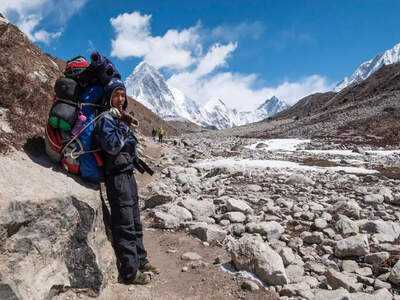The news of the Mount Everest blizzard and thousands of mountaineers stuck in the mountains for hours now is all over. The sudden severe blizzard over the weekend on Mount Everest’s Tibetan side has prompted large-scale rescue operations. Chinese state media and international outlets are saying that hundreds were guided to safety while rescuers remained in contact with several hundred more who were trapped above 4,900 metres (about 16,000 ft).
The incident
The storm was sudden and happened during a busy period for tourists in China. It left hundreds of hikers stuck in their camps and they were overwhelmed by heavy snowfall and strong winds. Eye witnesses describe a scary scene wherein tents were nearly buried and snow piling up. Because of high altitude, extreme precipitation, and jammed tourist routes made it hard for rescue teams.
Reuters reported nearly 1,000 people were trapped on the Tibetan side and hundreds later escorted down and around 200 are still waiting to be rescued. Local authorities mobilised hundreds of rescuers and villagers; horses, oxen and drones were used in clearing and evacuation efforts. Fatalities related to hypothermia and altitude sickness have been reported.
A reminder for high-altitude tourism
The incident is a reminder that high-altitude tourism such as a guided trek to Everest Base Camp or a trip to the Everest Scenic Area is exposed to sudden weather changes. Though October is considered a popular month for Himalayan adventures, weather at extreme altitudes is unpredictable. It can turn into a life-altering event in some time.
How to stay safe in blizzard
Considering what happened at Everest, here are some practical steps trekkers and tourists should take if stuck in a blizzard. These are taken from mountain-rescue organisations and meteorological safety guidance:
Preparation before you leave for your adventure

Double check weather forecasts
Check official advisories
Consult local authorities
Make sure tourism board and mountain rescue organisations know you
Carry verified emergency contacts
Keep a charged satellite or local phone number
Hire official guides only
Permits are important, so travel only with licensed operators
Understand evacuation procedures before departure
Pack survival gear such as insulated sleeping bag, waterproof clothes, spare shoes, gloves,hats
High-energy food such as chocolates and protein bars and first-aid kit
Acclimatise
In case you’re already on the mountain and get stuck in a blizzard:

Seek or prepare shelter immediately
Stay put unless you have a safe, marked route downhill and visibility allows it
Monitor for hypothermia and altitude illness. Try to keep yourself dry, eat and sip fluids
Avoid alcohol or sedatives
Conserve battery power on communication devices
The recent blizzard on Everest is a reminder of how important it is to be prepared for an unknown crisis. In such a crisis, remember shelter, warmth and presence of mind can keep you safe.
The incident
The storm was sudden and happened during a busy period for tourists in China. It left hundreds of hikers stuck in their camps and they were overwhelmed by heavy snowfall and strong winds. Eye witnesses describe a scary scene wherein tents were nearly buried and snow piling up. Because of high altitude, extreme precipitation, and jammed tourist routes made it hard for rescue teams.
Reuters reported nearly 1,000 people were trapped on the Tibetan side and hundreds later escorted down and around 200 are still waiting to be rescued. Local authorities mobilised hundreds of rescuers and villagers; horses, oxen and drones were used in clearing and evacuation efforts. Fatalities related to hypothermia and altitude sickness have been reported.
A reminder for high-altitude tourism
The incident is a reminder that high-altitude tourism such as a guided trek to Everest Base Camp or a trip to the Everest Scenic Area is exposed to sudden weather changes. Though October is considered a popular month for Himalayan adventures, weather at extreme altitudes is unpredictable. It can turn into a life-altering event in some time.
How to stay safe in blizzard
Considering what happened at Everest, here are some practical steps trekkers and tourists should take if stuck in a blizzard. These are taken from mountain-rescue organisations and meteorological safety guidance:
Preparation before you leave for your adventure

Double check weather forecasts
Check official advisories
Consult local authorities
Make sure tourism board and mountain rescue organisations know you
Carry verified emergency contacts
Keep a charged satellite or local phone number
Hire official guides only
Permits are important, so travel only with licensed operators
Understand evacuation procedures before departure
Pack survival gear such as insulated sleeping bag, waterproof clothes, spare shoes, gloves,hats
High-energy food such as chocolates and protein bars and first-aid kit
Acclimatise
In case you’re already on the mountain and get stuck in a blizzard:
Seek or prepare shelter immediately
Stay put unless you have a safe, marked route downhill and visibility allows it
Monitor for hypothermia and altitude illness. Try to keep yourself dry, eat and sip fluids
Avoid alcohol or sedatives
Conserve battery power on communication devices
The recent blizzard on Everest is a reminder of how important it is to be prepared for an unknown crisis. In such a crisis, remember shelter, warmth and presence of mind can keep you safe.
You may also like

Pakistan: Massive explosion on Jaffar Express derails 6 coaches; several injured

EAM Jaishankar calls for balanced approach to AI, says trust and safety must guide innovation

Major highways, roads closed due to heavy rain, snowfall in J-K

Bihar elections: BJP takes dig at Lalu Prasad Yadav over PM face; mocks 'family problems'

BB 19: Ashnoor Kaur's parents react to her ugly fights, says "Thought of pulling her out of the show"






